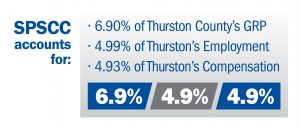Most of us know that South Puget Sound Community College (SPSCC) is an economic driver within our region. The school employs hundreds of faculty and staff and provides career-connected learning to thousands of students.

But its overall impact, recently revealed through an economic impact study commissioned through the Thurston Economic Development Council, is greater than you might suspect. Once the supply chain effects were factored in, the study found that the college creates nearly a billion dollars per year in total economic production.
Gene Angel, research manager at the EDC, explains that impact studies measure economic events or a given organization’s economic impact as it cascades through a regional supply chain. “Your organization has its own operations budget and employees, but to exist, you have to purchase from another business to maintain those operations,” he says. “That business, in turn, has to purchase from another company to get those supplies. That’s the multiplier effect.”
The studies can be highly effective tools for organizations that need to raise funds, Angel notes. “If you’re a nonprofit and you need to demonstrate a return on investment to your funders, this is a way to show that you’ve been good stewards of that money,” he explains. “Not only is it going toward the service of your mission, but it also has tangible economic outcomes for the community.”

For those seeking public funds, such studies are particularly compelling because they can benchmark an organization against other programs in terms of metrics like total cost per job created. “It’s a tool for public officials to understand the effects of giving you that funding,” says Angel. The EDC offers the studies as a fee for service, with rates dependent on the level of complexity.
To arrive at the numbers, the study looks at three levels of impact: direct, indirect and induced. The direct category includes operations and employees, indirect highlights supply chain purchasing, and induced examines the impacts of increased wages as a result of those purchases.
“Those companies you’re buying from need to buy from another business to fill those orders,” Angel explains. “All of that together creates an increase in wages for workers. When someone gets an increase in pay, they’re able to purchase more health care, groceries, etc. When we sum them up in total, that’s how we get the total supply chain impact.”

Angel describes the target market for such studies as “anyone who is trying to demonstrate their organization’s value to anyone else.” “They’re an effective way to understand what your impact is,” he adds, “in terms of jobs created, labor income added, total production value and the value of final goods and services.”
Learn more by visiting the Thurston Economic Development Council website or calling 360.754.6320.
Sponsored




















































